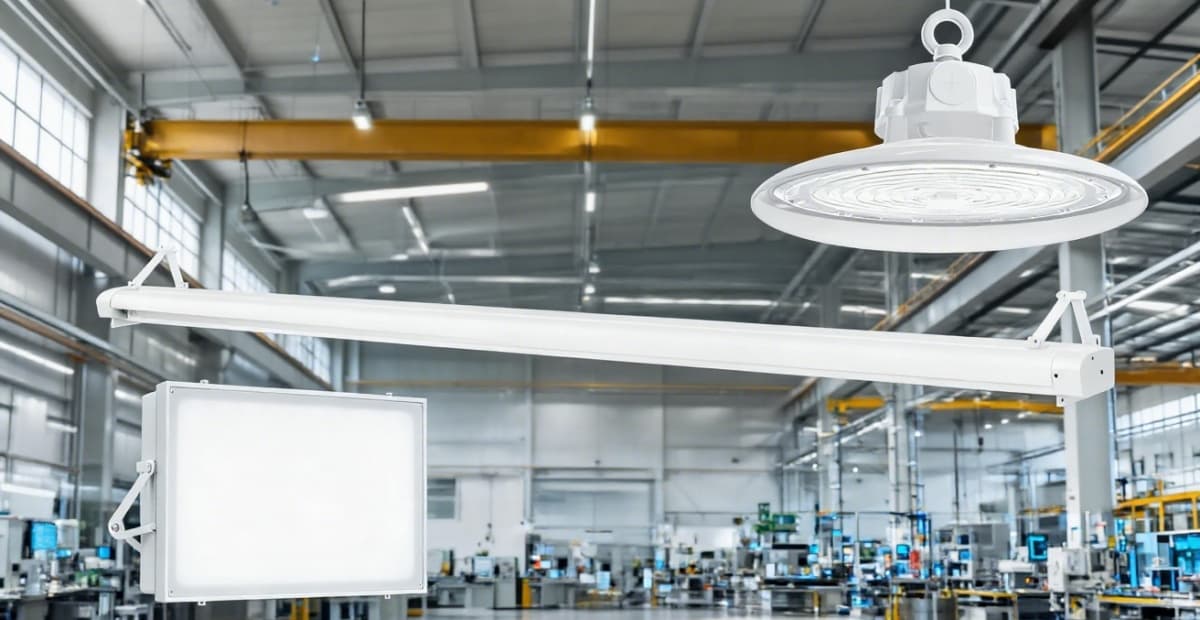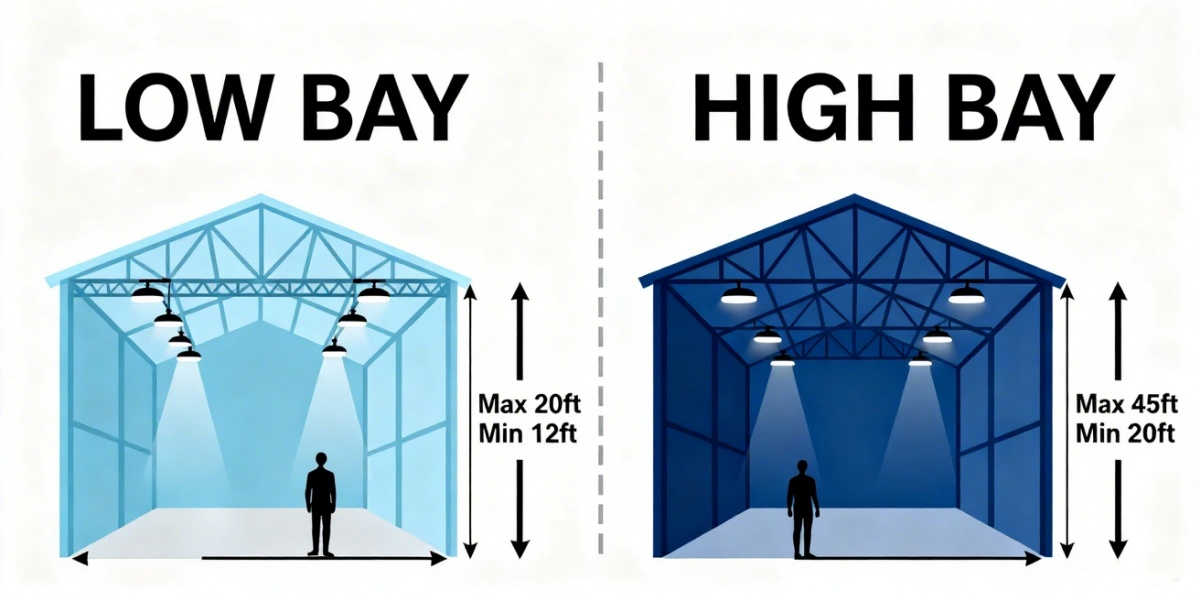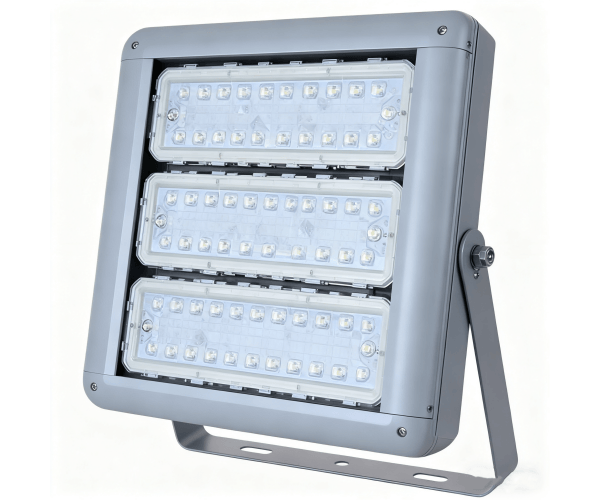工业LED高棚灯:完整指南

大空间需要强大的照明功率——而这正是工业LED高棚灯 发挥作用的地方。
如果您曾经想过如何在不浪费能源或金钱的情况下照亮大型工业空间,本指南将带您了解您需要知道的一切。
目录:
什么是工业LED高棚灯?
工业LED高棚灯 听起来很高端,但原理其实很简单——它是专为普通灯具无法满足需求的高层空间而设计的照明设备。例如,工厂、仓库或飞机库等天花板高度超过20英尺(约6米)的场所。
当屋顶离地面很远时,你需要强劲而集中的光线,确保光线能够真正照射到地面。这正是高棚灯的设计初衷。
过去,金属卤化物灯或荧光灯等传统照明方式 是首选,但说实话——它们发热量大、耗电量高,而且总是在最糟糕的时候烧坏。
工业LED灯彻底颠覆了这种局面。它们在提供相同(甚至更高)亮度的同时,能耗却只有传统灯具的一半左右,而且在需要维护之前,可以持续发光5万小时甚至更久。
简而言之,它们是更智能、更坚固、更高效的大型工业空间照明方式。合适的高棚灯系统可以将昏暗沉闷的仓库变成明亮、安全、节能的工作空间。

高棚灯与低棚灯——主要区别
你是否曾经走进两家不同的工厂,发现一家光线明亮如阳光,而另一家光线均匀柔和?这种差异通常源于高棚灯和低棚灯——这两种照明系统是为截然不同的天花板高度和照明需求而设计的。
高棚灯专为高处空间(通常为20 英尺或更高) 设计,在这些空间中,光线需要传播更远距离并保持强度。它采用较窄的光束角 ,将光线集中照射到下方的工作区域。
另一方面,低棚灯更适合20英尺以下的房间,它采用更宽的光束角 ,将光线均匀地照射到较短的距离上。它非常适合车间、零售区和车库等不需要远距离“照明”的场所。

以下是一个简单的对比图表,以便更清楚地说明:
特征 | 高棚照明 | 低棚照明 |
安装高度 | 超过 20 英尺(6 米) | 低于 20 英尺(6 米) |
光束角 | 窄(60°–120°) | 宽(120°以上) |
应用程序 | 仓库、工厂、体育馆、机库 | 车间、车库、零售商店、走廊 |
光分布 | 聚焦、明亮、反射较少 | 更柔和、均匀的照明 |
维护 | 难以到达,但寿命长 | 更易于维护,更换频率更高 |
简而言之——选择灯具时应考虑高度,而非形状。如果灯具需要从高高的天花板向下照射,那就选择高棚灯。对于较小的房间或较低的天花板,低棚工业LED照明灯是更明智的选择。
工业LED高棚灯的类型
每个工业空间都有其独特的个性——有些狭长如仓库通道,有些宽阔如工厂车间。
因此,LED高棚灯主要 有三种设计:线性高棚灯、UFO型LED高棚灯和模块化高棚灯。每种类型都适用于不同的工作空间和照明目标。
以下是简要概述:
类型 | 非常适合 | 主要特点 | 典型形象 |
线性高棚灯 | 仓库、通道、生产线 | 光线分布均匀,非常适合狭长区域。 | 矩形或条形 |
UFO LED高棚灯 | 开放空间——工厂、体育馆、车间 | 结构紧凑、功能强大、易于安装 | 圆形、碟状设计 |
模块化高棚灯 | 大型工业园区,定制项目 | 可调节模块、可扩展亮度、维护简便 | 板式结构 |
类型 1:线性高棚灯
线性高棚灯是仓库和生产通道 的理想之选。它们细长的矩形灯体能将光线均匀地投射到整个通道上,非常适合需要从一端到另一端亮度一致的场所。它们可以巧妙地安装在货架之间,减少阴影,让您的工作空间安全舒适,呵护您的双眼。

类型 2:UFO LED 高棚灯
UFO LED高棚灯结构紧凑、圆润坚固, 专为对高度和照射范围要求极高的开放式工业区域而设计 。尽管体积小巧,它们却能提供令人印象深刻的亮度和出色的光束控制。其设计也使得安装异常简便——只需悬挂、连接即可。是需要强劲均匀照明的工厂、车间和体育馆的理想之选 。

第3类:模块化高棚灯
对于需要灵活性的项目,模块化高棚灯 是切实可行的解决方案。其模块化结构意味着您可以组合多个 LED 面板以提高输出功率,或调整光束方向以适应布局。它们广泛应用于大型工业厂房或定制照明系统中 ,在这些应用中,性能和可扩展性缺一不可。

简而言之——线性灯 使过道明亮均匀,UFO 灯 轻松应对开放空间,模块化灯 让您完全掌控。
高棚LED灯用于哪些场所?
高棚LED灯在哪里? 真的要闪闪发光吗?凡是天花板高的地方,工作都很严肃,照明就不能马虎。
这些灯具是仓库、工厂、车间、体育馆,甚至是飞机库的首选——基本上,任何需要从上方获得明亮、稳定照明的空间都适用。
在仓库 和配送中心,照明需要深入货架之间,且不能产生阴影。线性高架灯 是理想之选——它们能将均匀的光线投射到长长的通道上,使工作人员能够清晰地看到每一个条形码。
在工厂 和生产车间,亮度和安全性至关重要。机器、工具和人员都在快速移动,因此强劲均匀的照明可以减少事故和眼部疲劳。UFO或模块化高棚灯可以轻松应对这些高强度任务,确保一切清晰可见且高效运行。
车间照明 值得单独关注。无论是金属加工、汽车维修还是精细装配工作,这些空间都需要清晰明亮的光线和聚焦的视野。高棚LED灯能够提供工人所需的清晰无阴影照明,并具有出色的色彩精准度,便于区分不同的材料和表面处理。
在体育馆或运动场馆,舒适度才是关键。你需要充足的光线,但又不能有眩光,确保运动员能看清球,而不是被星星遮挡。高棚LED灯平衡了光照强度和漫射效果,营造出明亮而舒适的环境。
无论空间大小,合适的灯具设计——例如用于过道的线性灯具、用于开放区域的UFO灯具、用于定制的模块化灯具——都能确保你的照明不仅仅是发光;它还能像你一样努力工作。
工业LED高棚灯的三大优势
为什么这么多工厂都在用LED高棚灯替换金卤灯或荧光灯?
这不仅仅是跟上技术潮流的问题——更重要的是以更低的成本获得更好的照明效果。工业LED高棚灯将高效、可靠和高性能完美融合于一体,长期来看,其投资回报显而易见。
Benefit 1: Energy Efficiency & Power Saving
Let’s start with the obvious win — energy bills. LED high bay lights use 60–70% less power than metal halide and around 40% less than fluorescent systems. They convert more electricity into light instead of heat, which means you get brighter illumination without turning your factory into an oven. In short: less power, more light, smaller bills.
Benefit 2: Longevity & Maintenance
Tired of changing bulbs on a 30-foot ceiling? LEDs have you covered. With lifespans of 50,000–100,000 hours, they last five to ten times longer than metal halide lamps. That means fewer replacements, less downtime, and happier maintenance crews. Industrial spaces like warehouses and factories love that kind of consistency.
Benefit 3: Light Quality & Performance
LED high bays also shine (literally) when it comes to light quality. They deliver a high CRI (80+), providing natural, accurate color visibility that reduces eye strain. No warm-up time, no flickering — just clean, steady light from the moment you flip the switch.
No flicker, no waiting, no drama — just clean, consistent light.
Quick Comparison: LED vs. Traditional Lighting
Feature | LED High Bay | Metal Halide | Fluorescent |
Energy Efficiency | ★★★★★ | ★★☆☆☆ | ★★★☆☆ |
Lifespan | 50,000–100,000 hrs | 10,000 hrs | 15,000–20,000 hrs |
Warm-Up Time | Instant | 5–10 min | Instant |
CRI | 80+ | 65–70 | 75 |
Maintenance | Low | High | Medium |
LED high bay lights aren’t just replacements — they’re upgrades that redefine how industrial spaces are illuminated.
What’s the ROI of Industrial LED High Bay Lighting?
Switching to industrial LED high bay lighting isn’t just a lighting upgrade — it’s a smart business move. Many facility managers start with one simple question: “Will it actually pay off?” The short answer? Yes — and usually faster than you’d expect.
Energy Savings That Add Up Fast
Energy costs are the biggest chunk of any lighting budget. LED high bays use 50–70% less electricity compared to metal halide fixtures and about 40% less than fluorescent systems. For a warehouse running 100 fixtures at 400W each, that’s roughly $10,000–$15,000 saved per year (depending on local rates and operating hours).
Less power drawn, less heat produced — your lighting bill (and your air conditioning bill) both go down.
Tip: Check your utility’s rebate programs — many offer cash incentives for upgrading to LED systems.
Longer Lifespan, Lower Maintenance
Here’s another hidden ROI factor: maintenance. LED high bay lights typically last 50,000–100,000 hours, meaning you can go 8–10 years before replacements. Compare that to metal halides, which need re-lamping every 1–2 years.
That’s fewer lifts, fewer ladders, and fewer interruptions to production. And in industrial settings, every maintenance hour you save is an hour of work you don’t lose.
Realistic Payback Period: 3–5 Years
In most industrial applications, LED upgrades deliver a return on investment within 3 to 5 years. After that, the energy and maintenance savings are pure profit.
For example, a facility that spends $20,000 annually on lighting can see its costs drop to around $7,000 after switching to LED — saving $13,000 each year. Multiply that over five years, and the numbers speak for themselves.
ROI Beyond the Spreadsheet
Sure, the financial side is great — but LEDs also improve lighting quality, worker safety, and comfort, which can indirectly boost productivity. Better light equals fewer mistakes and happier employees.
In short: industrial LED high bay lighting isn’t an expense; it’s an investment that pays for itself, one bright workspace at a time.
How to Plan Your High Bays Layout?
Getting industrial LED lighting right isn’t just about picking the best fixture — it’s about knowing how to plan the layout. These two questions—quantity and brightness—are what truly shape a good lighting plan.
Let’s walk through how to get both right without turning your factory floor into either a spotlight stage or a cave.
Step 1: Measure Your Space
Before diving into any calculations, start with the basics: measure your space. You’ll need:
Area: in square meters or square feet
Ceiling height: the higher it is, the stronger your lights need to be
Surface reflectivity: bright walls bounce light better than dark ones
Purpose: production lines, warehouses, or inspection zones each need different brightness levels
A warehouse and a gym might be the same size — but they definitely don’t need the same light levels.
Step 2: Estimate Lamp Quantity
Once you’ve got your measurements, here’s a quick way to estimate how many fixtures you’ll need.
A general formula goes like this:
Number of lights ≈ (Target Lux × Area) ÷ (Lumens per fixture × Utilization factor)
Let’s say you have a 1,000 m² warehouse, aiming for 300 lux, and you’re using 26,000-lumen high bays. You’ll need around 12–14 fixtures for balanced coverage.
Of course, professional lighting design software like Dialux or Relux can provide more precise results, but this quick math gives you a solid starting point for budgeting.
Step 3: Choose the Right Brightness (High Bay Lumens Chart)
Here’s a simple reference chart to help match your ceiling height with the ideal light output:
Mounting Height | Recommended Lumens per Fixture | Typical Application |
20–30 ft | 22,000–35,000 lm | Warehouse, workshop |
31–40 ft | 35,000–47,000 lm | Factory, gym, hangar |
40+ ft | 47,000+ lm | Heavy industry, aircraft bays |
The logic is simple: the higher the ceiling, the more powerful the fixture. Go too dim, and you’ll have dark corners and safety risks. Go too bright, and you’ll waste watts and money. Balance is key.
Step 4: Fine-Tune for Efficiency
Once you’ve nailed the basics, optimize with the right beam angle and layout pattern:
Wide beam (120°): better for low ceilings and open areas
Narrow beam (60°–90°): ideal for high ceilings or focused lighting zones
Think of it as lighting choreography — the right placement keeps every corner bright without stepping on your power bill.
Conclusion
Industrial LED high bay lighting isn’t just about brightness — it’s about efficiency, safety, and real ROI. By switching to LEDs, factories and warehouses cut energy bills, reduce maintenance, and create a safer, brighter workspace for years to come.
Ready to take the next step?
Explore Ceramiclite’s HB01 LED high bay lights designed for every industrial environment, or contact our experts for a free lighting audit to see how much you could save.
FAQs
Q1: Can LED high bay lights be used outdoors?
Yes — as long as they’re rated IP65 or higher. That rating means they’re dust-tight and weatherproof enough for outdoor or semi-outdoor spaces like loading docks or covered stadiums. Just don’t stick an indoor fixture out in the rain and expect it to thank you.
Q2: Are LED high bay lights dimmable for flexible lighting control?
Absolutely. Many Ceramiclite models support 0–10V dimming or smart controls, letting you adjust brightness based on task or daylight. It’s not just convenient — it also saves energy and extends the lamp’s lifespan. Think of it as giving your factory its own mood lighting (but for productivity, not romance).
Q3: What warranties do Ceramiclite high bay lights come with?
Most of our fixtures include a 8-year warranty, covering both performance and parts. Because industrial lighting isn’t a short-term investment — and we stand behind every lumen we sell.
问题四:LED高棚灯的使用寿命有多长?
通常为5万至10万小时,具体取决于使用情况和环境。这相当于大约10年 的可靠照明——远长于金属卤化物灯或荧光灯。简而言之:一次安装,多年无忧。
Q5:LED灯只是昙花一现的潮流吗?
绝无可能。LED灯代表着工业照明的未来——节能高效、智能化、经久耐用。真正会被淘汰的是传统白炽灯泡。
Q6:更换灯具时应该如何处理旧灯泡?
金属卤化物灯泡和荧光灯泡通常含有需要妥善回收或处理的材料。Ceramiclite 的支持团队可以帮助您联系经过认证的回收商,确保您的升级过程清洁、安全且符合相关规定。
_thumb.jpg)